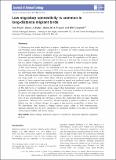Files in this item
Low migratory connectivity is common in long-distance migrant birds
Item metadata
| dc.contributor.author | Finch, Tom | |
| dc.contributor.author | Butler, Simon J. | |
| dc.contributor.author | Franco, Aldina M. A. | |
| dc.contributor.author | Cresswell, Will | |
| dc.date.accessioned | 2017-04-12T09:30:11Z | |
| dc.date.available | 2017-04-12T09:30:11Z | |
| dc.date.issued | 2017-04-10 | |
| dc.identifier | 248203756 | |
| dc.identifier | 52832653-effe-48ff-aff3-ae357b0f3f25 | |
| dc.identifier | 85013919230 | |
| dc.identifier | 000398826400025 | |
| dc.identifier.citation | Finch , T , Butler , S J , Franco , A M A & Cresswell , W 2017 , ' Low migratory connectivity is common in long-distance migrant birds ' , Journal of Animal Ecology , vol. 86 , no. 3 , pp. 662-673 . https://doi.org/10.1111/1365-2656.12635 | en |
| dc.identifier.issn | 0021-8790 | |
| dc.identifier.other | ORCID: /0000-0002-4684-7624/work/60426913 | |
| dc.identifier.uri | https://hdl.handle.net/10023/10612 | |
| dc.description | TF benefitted from a Natural Environment Research Council studentship (student number 6109659) and AF from a Natural Environment research grant NE/K006321/1. | en |
| dc.description.abstract | 1. Estimating how much long-distance migrant populations spread out and mix during the non-breeding season (migratory connectivity) is essential for understanding and predicting population dynamics in the face of global change. 2. We quantify variation in population spread and inter-population mixing in long- distance, terrestrial migrant land-bird populations (712 individuals from 98 populations of 45 species, from tagging studies in the Neotropic and Afro-Palearctic flyways). We evaluate the Mantel test as a metric of migratory connectivity, and explore the extent to which variance in population spread can be explained simply by geography. 3. The mean distance between two individuals from the same population during the non- breeding season was 743 km, covering 10–20% of the maximum width of Africa / South America. Individuals from different breeding populations tended to mix during the non-breeding season, though spatial segregation was maintained in species with relatively large non-breeding ranges (and, to a lesser extent, those with low population-level spread). A substantial amount of between-population variation in population spread was predicted simply by geography, with populations using non- breeding zones with limited land availability (e.g. Central America compared to South America) showing lower population spread. 4. The high levels of population spread suggest that deterministic migration strategies are not generally adaptive; this makes sense in the context of the recent evolution of the systems, and the spatial and temporal unpredictability of non-breeding habitat. 5. The conservation implications of generally low connectivity are that the loss (or protection) of any non-breeding site will have a diffuse but widespread effect on many breeding populations. Although low connectivity should engender population resilience to shifts in habitat (e.g. due to climate change), we suggest it may increase susceptibility to habitat loss. We hypothesise that because a migrant species cannot adapt to both simultaneously, migrants generally may be more susceptible to population declines in the face of concurrent anthropogenic habitat and climate change. | |
| dc.format.extent | 12 | |
| dc.format.extent | 1062790 | |
| dc.language.iso | eng | |
| dc.relation.ispartof | Journal of Animal Ecology | en |
| dc.subject | Climate change | en |
| dc.subject | Migration | en |
| dc.subject | Migratory connectivity | en |
| dc.subject | Migratory dispersal | en |
| dc.subject | Population declines | en |
| dc.subject | GE Environmental Sciences | en |
| dc.subject | QH301 Biology | en |
| dc.subject | QL Zoology | en |
| dc.subject | DAS | en |
| dc.subject | BDC | en |
| dc.subject | R2C | en |
| dc.subject | SDG 13 - Climate Action | en |
| dc.subject | SDG 15 - Life on Land | en |
| dc.subject.lcc | GE | en |
| dc.subject.lcc | QH301 | en |
| dc.subject.lcc | QL | en |
| dc.title | Low migratory connectivity is common in long-distance migrant birds | en |
| dc.type | Journal article | en |
| dc.contributor.institution | University of St Andrews. School of Biology | en |
| dc.contributor.institution | University of St Andrews. Scottish Oceans Institute | en |
| dc.contributor.institution | University of St Andrews. Institute of Behavioural and Neural Sciences | en |
| dc.contributor.institution | University of St Andrews. St Andrews Sustainability Institute | en |
| dc.contributor.institution | University of St Andrews. Centre for Biological Diversity | en |
| dc.identifier.doi | 10.1111/1365-2656.12635 | |
| dc.description.status | Peer reviewed | en |
| dc.date.embargoedUntil | 2017-04-10 |
This item appears in the following Collection(s)
Items in the St Andrews Research Repository are protected by copyright, with all rights reserved, unless otherwise indicated.

